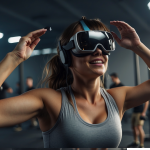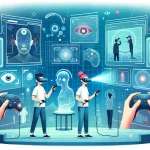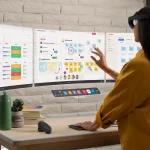

Since Apple announced the introduction of the Apple Vision Pro the tech community is in an uproar. The pre-orders of over 200,000 units not only reflect the immense market expectation, but also underline Apple's remarkable influence in the technology sector. A pioneering device in spatial computing, the Vision Pro integrates advanced virtual reality (VR) and augmented reality (AR) technologies, powered by VisionOS. This integration promises to merge the digital with the physical through a three-dimensional user interface, a novel approach that redefines interaction with technology.
The Apple Vision Pro offers an impressive range of functions such as eye-tracking, spatial sound and sophisticated computer vision. However, superior hardware is not enough to establish a product successfully on the market. What about the range of apps for the Apple Vision Pro? If you have already seen the demos supplied and you search for new content in the App Store, the picture is sobering. There is hardly any range of apps for Apple's spatial computing platform and little seems likely to change in the short term.
Despite the Vision Pro's innovative hardware and software capabilities, its success and benefits depend on the availability and variety of applications. The Vision Pro is currently facing an "app shortage". There are currently only 150 apps available for the Apple Vision Pro. This scarcity of apps will significantly limit the practicality of the device and hinder its integration into everyday life, limiting it to the status of a novel gadget that excites tech enthusiasts but remains irrelevant to a wide audience.
The lack of Vision Pro apps can be attributed to several factors. Firstly, there is the Challenge in developing for a new and complex platform. The Vision Pro's mixed reality environment, combined with high expectations of the user experience, sets a high barrier to entry for app developers. In addition, the economic risk of investing in a new platform could deter developers until there is a clearer indicator of the device's market success. The user base for Apple Glasses is small.
To move beyond its current status as a novelty and become a standard in spatial computing, it is essential to maintain a robust app ecosystem. This ecosystem is important for several reasons:
To fully realize the potential of the Vision Pro and ensure that it lives up to its potential as a transformative device in spatial computing, Apple needs to take a more proactive stance with developers. It seems that Apple has relied on developers jumping on the Apple Vision Pro bandwagon without any incentives. It worked well for the iPhone. However, thanks to rapidly growing sales figures, there were already enough buyers for apps when the iPhone was launched. But this is not the case with the Vision Pro. Here it looks more like the sales figures are falling. It is not possible to say exactly as Apple has not published any figures. The fact that no more players are being found online for Vision Pro multiplayer game apps is not a good sign.
Offering subsidies or financial incentives to offset the cost of hardware and development tools could make the platform more accessible to a wider range of developers. As a developer, it currently feels like Apple is charging potential developers for their new platform rather than compensating them. High costs for software licenses and Apple proprietary hardware leave developers deep in their pockets. We are talking about investments of around €8,000
Providing comprehensive technical support, including advanced developer kits, detailed documentation and direct access to Apple's engineering support, can help developers overcome technical challenges more efficiently. Currently, the barrier to developing for Apple's Vision OS, even at the software level, seems very high even for experienced XR developers. It is much more difficult to develop software for Apple's glasses with common game engines such as Unreal and Unity than it is for the Meta Quest glasses, for example.
The Apple Vision Pro is on the cusp of making spatial computing and mixed reality experiences attractive to the masses. But for it to reach this potential, a concerted effort is needed to expand its app ecosystem. By fostering an environment that supports innovation and reduces the barriers to app development, Apple can ensure that the Vision Pro goes beyond the status of an innovative gadget and becomes a real tool in our digital lives.

Are you interested in developing a virtual reality or 360° application? You may still have questions about budget and implementation. Feel free to contact me.
I am looking forward to you
Clarence Dadson CEO Design4real






